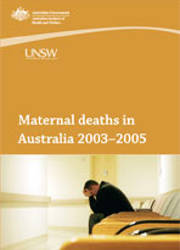Summary
The Australian community expects high quality clinical care during pregnancy and childbirth leading to a safe birth for the mother and her baby. Maternal mortality is one important measure of this care. Using this measure, Australia continues to be one of the safest countries in which women give birth.
This fourteenth triennial report presents an epidemiological overview of maternal deaths in Australia for the period 2003-2005. It has been prepared by the Australian Institute of Health and Welfare (AIHW) under the auspices of the Institute's National Advisory Committee on Maternal Mortality (NACMM)-see Appendix 1 for membership.
Australia's low maternal mortality rate
Over the three years, 65 deaths were classified as directly or indirectly relating to the pregnancy or its management, with all deaths occurring while the women were pregnant, or within 42 days of termination of pregnancy.
During the triennium, one woman died for every 11,896 women giving birth, giving a maternal death ratio of 8.4 per 100,000 of women giving birth. This compares favourably with the reported Maternal Mortality Rates (MMR) in other developed countries (WHO 2007).
Indigenous results are the great exception
Maternal mortality rates for Aboriginal or Torres Strait Islander women were more than two and a half times as high as for other women. There were 21.5 deaths per 100,000 women giving birth, versus 7.9 per 100,000 for non-Indigenous women.
This high rate is consistent with previous reports. The lack of improvement indicates that further measures are needed to improve the pregnancy outcomes for Aboriginal and Torres Strait Islander women.
Leading causes of maternal deaths
The leading causes of direct maternal deaths were: amniotic fluid embolism, thromboembolism and hypertension. Cardiac disease, psychiatric related causes and non- obstetric haemorrhage were the main indirect causes of maternal deaths.
The need for more information
An important finding from this report is that the current system for reporting maternal deaths needs to be enhanced to reflect changes in safety and quality initiatives. The current data system lacks the quality and sufficiency of information on risk factors, clinical pathways and management to allow adequate analysis of the deaths in order to inform recommendations on policy and practice change.



